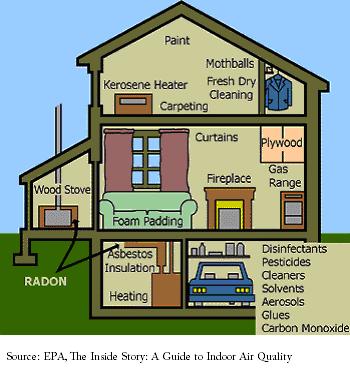
The word “home” evokes a safe place, a refuge from any dangers lurking outdoors. However, since 1990 the EPA has consistently ranked indoor air pollution as one of the top five environmental risks to public health. Concern over indoor air quality has increased with greater awareness of health problems caused by mold and triggers to asthma, allergies, and chemical sensitivities. At the mildest level, indoor air pollution’s effects may include irritation of the eyes, nose, and throat, headaches, dizziness, and fatigue. Respiratory disease, heart disease, and cancer may occur or be exacerbated with extended or repeated exposure to polluted indoor air.
Some indications of air quality problems in homes include:
- Rooms feel “stuffy” or have a mildew (musty) smell
- Air fresheners or scented candles are regularly used to improve the smell in the home
- Moisture is present on the inside of window panes
- Excessive dust is visible on flat surfaces
- Family members often sneeze, feel lethargic, or have dry skin
The US EPA lists 3 basic strategies for improving air quality: controlling source pollutants, cleaning the air, and improving ventilation.
1. Source Control
The first step in improving indoor air quality is to consider where the pollutants come from in the first place. Many products and furnishings introduce chemicals into the air. It is best to avoid cleaning products that feature health warnings or the all-too-familiar skull and crossbones symbol. Consider either buying natural, non-toxic cleaning products or making your own. Many common air fresheners actually degrade air quality. The Natural Resources Defense Council (NRDC) tested 14 different air fresheners and found that all but two contained measurable levels of phthalates, synthetic chemicals linked to asthma, endocrine disruption, and other serious health problems. Choose soy- or beeswax-based candles whenever possible. They are more expensive, but generally have a longer life and emit much lower levels of VOCs (volatile organic compounds).
Select natural personal care products, or use the bathroom fan when using synthetic products. For home renovation projects, use no-VOC or low-VOC paints, stains, and sealers. MDF (medium-density fiberboard) and particle board usually contain high levels of formaldehyde which continuously leach into the air (off-gas). Opt for furnishings made from solid wood and natural fabrics. Use only pesticides which are not toxic to humans – the chemicals used to kill insects often are also harmful to humans.
Radon is the second leading cause of lung cancer in the United States today. If your home is at ground level, a simple test can identify whether or not you are at risk.
Carbon monoxide is a colorless, odorless gas that is a byproduct of incomplete combustion of fossil fuels. Common sources of carbon monoxide are tobacco smoke, space heaters that use fossil fuels, defective central heating furnaces, and automobile exhaust. Because carbon monoxide is deadly, make sure to have gas heating systems inspected and cleaned yearly and never idle cars inside an attached garage.
Carbon dioxide is the general cause of what is often experienced as “stuffy air.” Carbon dioxide is a by-product of breathing and combustion (e.g., from fireplaces, gas stoves, water heaters, HVAC equipment, and candles). Excessive levels of carbon dioxide can affect alertness and cause fatigue. High levels of carbon dioxide often indicate improper or ineffective ventilation, which also leads to unhealthy levels of other indoor air pollutants.
Natural allergens also contribute to poor air quality. Mold tends to crop up when humidity is high. Pollen generally come from outdoors, and depending on the season, may cause hay fever and aggravate respiratory problems. Dander from pets is another source of allergens.
Inexpensive, easy-to-use test kits are widely available for periodic monitoring of home air quality. These kits can help identify problems with mold, carbon monoxide, radon, or asbestos.
2. Air Purifiers
Another step in improving air quality is to filter and purify indoor air. Make sure to regularly replace the filters used in central cooling and heating systems. Regularly clean the vents in kitchens, bathrooms, and dryers, and make sure they operate properly. While vacuum cleaners can be a source of dust, vacuums with advanced HEPA filtration can actually help to clean the air as you clean your carpets and floors.
Air purifiers come in models to service areas from single rooms to the whole house. Two common technologies available involve either filtration of the air (e.g., forcing air through HEPA filters) or sterilization of the air (passing air by a UV-light to kill bacteria and other DNA-based pathogens). Avoid any air purifiers that generate ozone in the filtration process. Ozone is a lung irritant that can cause adverse health effects. If there are any smokers in the home, look for air purifiers that offer special filtration for tobacco smoke.
Nature’s air filtration machines, houseplants, can also play a role. Certain plants, including philodendron, spider plants, golden pothos, peace lilies, bamboo palms, mums, and English ivy are particularly helpful. They can slowly remove some dangerous toxins like formaldehyde, carbon monoxide, and benzene from the air.
3. Ventilation
Modern home building techniques have resulted in “tighter,” more energy-efficient homes. Without a controlled ventilation strategy, new homes are prone to a greater build-up of indoor air pollution. In the absence of adequate ventilation, any pollutants introduced indoors remain there and can accumulate. Ventilation helps dilute emissions from indoor sources and carries indoor air pollutants out of the home.
It is easy to improve ventilation by opening windows and doors, operating window or attic fans, or running a window air conditioner with the vent control open. Local bathroom or kitchen fans that exhaust outdoors remove contaminants directly from the room where the fan is located and also increase the outdoor air ventilation rate. It is particularly important to increase ventilation while involved in short-term activities that can generate high levels of pollutants - for example, painting, paint stripping, heating with kerosene heaters, cooking, or engaging in maintenance and hobby activities such as welding, soldering, or sanding.
However, if anyone in the home suffers from hay fever, increasing ventilation may not be feasible for parts of the year. Air purifiers may play a bigger role in improving air quality during these times.
After taking a few of the steps above, you and your family can breathe easy!
Below, you'll find a presentation created by DwellSmart about Improving Indoor Air Quality. This presentation was created for and delivered at a conference for the US Green Building Council of South Carolina.
